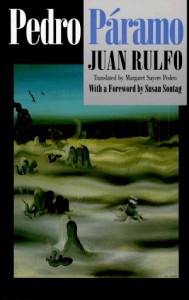 Pedro Páramo is the spookiest book I’ve read in a long time. Juan Rulfo created a world where the living interact with the dead in such a way that the reader can’t immediately be certain who is living and who is dead, which creates this suspicion that everyone is dead. Because the stories told about the lives of the dead are much more detailed and intricate than the stories of Juan Preciado, who is alive at the start of the book, the world of the dead seems more real than the world of the living.
Pedro Páramo is the spookiest book I’ve read in a long time. Juan Rulfo created a world where the living interact with the dead in such a way that the reader can’t immediately be certain who is living and who is dead, which creates this suspicion that everyone is dead. Because the stories told about the lives of the dead are much more detailed and intricate than the stories of Juan Preciado, who is alive at the start of the book, the world of the dead seems more real than the world of the living.
Spoilers Ahead
Rulfo does not immediately tell the reader that most of the ghosts Juan encounters are in fact dead, but on some level you can tell. Simple lines like “I saw a woman wrapped in her rebozo; she disappeared as if she had never existed” are easily read over and dismissed. Eduviges has had word from Juan’s dead mother that he is coming—perhaps she is sensitive to the spirit world. Later, Eduviges tells Juan that Abundio with whom he traveled to town is in fact long dead. Then Damiana says Eduviges is long dead.
My mind started stripping away the stories I had rationalized for myself and I started to see everyone as dead. I was so immersed in this novel that when a mentally ill woman perched next to me on a bench at lunch, I kept looking in her eyes to see if she was a ghost.
Layering Experiences
The way Rulfo intersperses short sections with glimpses of characters interacting with Juan and then follows up with a second more detailed section (sometimes then a third or even fourth) of the character in the past makes these spirits feel as alive as Juan Preciado is at the beginning of the novel. When Juan dies midway through the novel, I already felt like the majority of the story was in the flashbacks. I felt like I had been gradually led deeper and deeper into the spirit world until I was left there like Juan was.
I loved this book. I can learn a lot from the way Rulfo managed information so that he only revealed what was absolutely necessary to draw me further into the story. The mystery and suspense he created by mentioning Pedro Páramo’s name, then mentioning he was Abundio’s father also, “living bile,” and then later telling us he was dead. I hadn’t met this character and I wasn’t sure I wanted to, but he was immensely intriguing. I wondered if I could do something similar with Jacek in Polska, 1994 by building a reputation first and then introducing the character. I decided not to go that particular direction, but it definitely shapes a reader’s expectations. Every action Pedro Páramo took was tainted for me by Abundio’s preconceptions. Not that his actions, except in the case of his wife Susana were at all laudable.
Atmosphere and Mood
I also like what Rulfo did with the atmospheric descriptions. From walls “stained red by the setting sun” to lines like “February when the mornings are filled with wind and sparrows and blue light,” the description creates the mood of the story and impacts the reader’s understanding of it. The detail of the red stains recurs as Eduviges says goodbye to her sister who is also stained “by the dusk filling the sky with blood.” Whereas when Dorotea remembers the “February wind that used to snap the fern stalks before they died from neglect” and the “little whirlwinds [that swept] across the earth,” it feels like the air in Comala is still and has been for some time. There is no cleansing wind. There is no blue light. There is only heat and stillness and death. In annotating the book, it was actually difficult to decide which atmospheric details to choose because they were everywhere. However, Rulfo’s details blended so seamlessly into the story that they were at once omnipresent and sitting comfortably in the background.
If this review made you want to read the book, pick up a copy of Pedro Páramo from Bookshop.org. Your purchase keeps indie booksellers in business and I receive a commission.





Leave a Reply